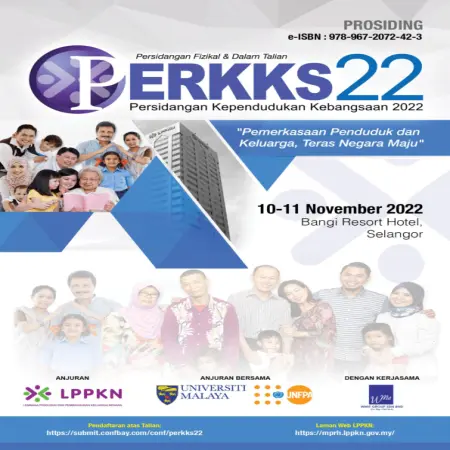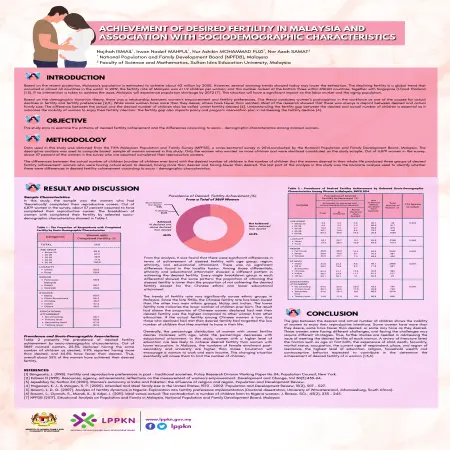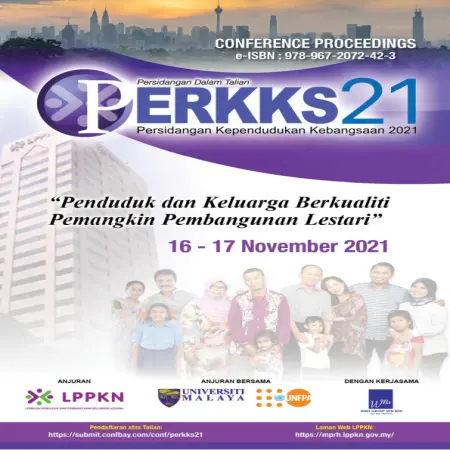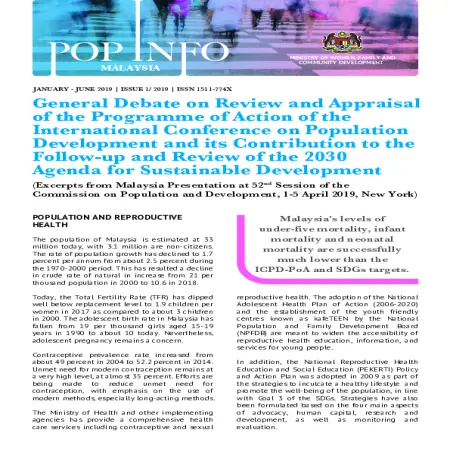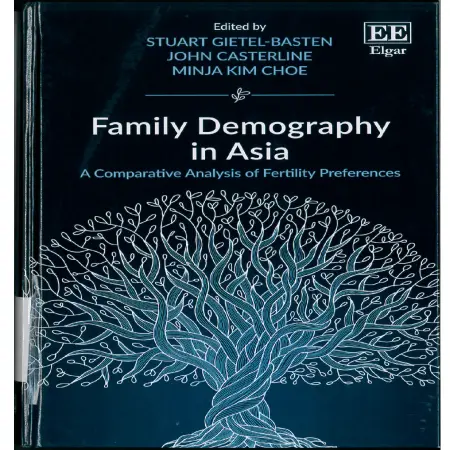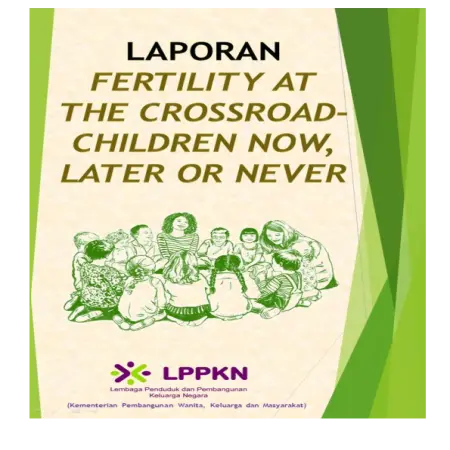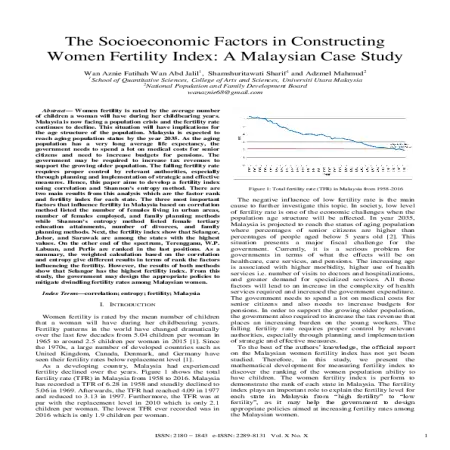TOPICS
Results for Topics : "Fertility"
|
|
Kadar kesuburan mengikut umur: suatu perbandingan perbezaan ufuk ramalan
Item Type: Book Section
Editor:
Year: 00/00/2022
Abstract: Population ageing is facing by most countries today. This issues is influenced by factors such as increased life expectancy, migration and decreased fertility rates. The optimal fertility rate is 2.1 which means the average birth rate for a woman is able to replace herself and her partner. However, Malaysia has recorded a worrying situation since 2013 when the total fertility in the country was below 2.1, which is below the global fertility rate. A low fertility rate will increase the old-age dependency ratio and in turn affect the country’s economic growth. This study aims to analyze the pattern and forecast of fertility rates in Malaysia for the years 2001 to 2016 by using Lee-Carter model.
|
|
|
|
|
|
Achievement of desired fertility in Malaysia and association with sociodemographic characteristics
Item Type: Scientific Poster
Editor:
Year: 00/00/2021
Abstract: This study aims to examine the patterns of desired fertility achievement and the differences according to socio - demographic characteristics among married women.
|
|
|
|
|
|
The impact of aging and fertility rate on economic growth in Malaysia: new evidence using ARDL model
Item Type: Book Section
Editor:
Year: 00/00/2021
Abstract: Population aging and the health status of the community are the primary agenda in the achievement of the Sustainable Development Goals 2030 (SDG, 2030). However, current trends in the world have shown a rapid increase in the aging population rate, whereas the birth rate has shown a downward trend. Malaysia is no exception in this regard, which is expected to become an old country status by 2030 when the population aged 60 years and above reaches 15% of the total population.
|
|
|
|
|
|
Seroprevalence and factors associated with chlamydia trachomatis Infection among subfertile couples attending local public subfertility clinic
Item Type: Thesis
Editor:
Year: 00/00/2020
Abstract: Chlamydia trachomatis is one of the agents that cause the sexually transmitted infections called chlamydia. People practicing risky sexual behaviours such as having multiple sex partners, exercising sexual intercourse at an early age, and undergoing unprotected sexual
intercourse (without condom) with casual partners, are at risk of getting Chlamydia trachomatis infection. One of the significant, long term implications of risky sexual behaviours and sexually transmitted infection is infertility problems. The objectives of this study are to determine the seroprevalence of Chlamydia trachomatis (CT) among subfertile couples (husband and wife) of The Lembaga Penduduk dan
Pembangunan Keluarga Negara (LPPKN) Subfertility Clinic and the factors associated with it (i.e. socio-demographic, duration of marriage, infertility factor, knowledge, attitude, practice of risky sexual behaviour (RSB) and predictors of Chlamydia trachomatis infection). The study is a cross-sectional study involving 112 infertile couples who underwent fertility treatment at LPPKN Subfertility Clinic from February 2018 until February 2019. Sociodemographic factors, duration of marriage, infertility factor, knowledge, attitude and practice (KAP) of risky sexual behavior (RSB) variables were determined via self-administered
questionnaire that includes close ended questions. Meanwhile, Chlamydia trachomatis antigen and antibody (CT IgG) were determined via Enzyme Linked Immunosorbent Assay (ELISA) and rapid visual immunoassay test kit. This approach is selected to detect past and
current infections of Chlamydia trachomatis through antibody and antigen detection in the blood serum, endocervical swab and urine samples. The response rate of this study was 97.39%. Majority of the respondents were aged between 25-34 years old and dominated by Malay ethnicity. Half of the respondents were among those with tertiary level of education and working in the private sector. In term of duration of marriage, half of the samples were couples who have been married for 3-7 years with majority of them had primary infertility. The female factor was reported to be the most dominant, followed by the unexplained factor and male factor. The seroprevalence of Chlamydia trachomatis among subfertile couples was 22.1% with 14.7% in husbands and 17.9 %, was reported among wives. In terms of knowledge, the results showed that most couples had high level of knowledge
about risky sexual behaviours with a score of more than the mean (> 6) for both husbands and wives. Meanwhile, each husband and wife group had positive attitude towards risky sexual behavior. Approximately, 35.7% of husbands and 12.5% of wives were engaged with risky sexual behavior while a higher percentage of premarital sex was reported among the husbands compared to the wives. The chi-square results showed no association between CT status and socio -demographic factors, marital status and knowledge of RSB among subfertile couples. A significant association was recorded between CT and practices of RSB among couples (p< 0.05) particularly among those with multiple sex partners and husbands who had premarital sex (p<0.05). However, the Binary Logistic Regression analysis showed that none of the selected variables were significant predictors of CT status among the couples (p> 0.05). This study has determined that the seroprevalence of Chlamydia trachomatis (22.1%) and practices of risky sexual behavior among subfertile couples were high. Even though the results have shown no association between the dependent and independent variables, our finding has given an evidence based detection of past infection of Chlamydia trachomatis among
subfertile couples. The practice of RSB has interrelated risk of getting CT and its long term consequences particularly on women reproductive system. Since the awareness on CT among public is considered low, it is crucial to sensitize them about it to ensure early detection and prevention. Therefore, CT screening is strongly recommended to be integrated in fertility work up. treatment and be promoted among sexually active adolescents and those young in age.
|
|
|
|
|
|
General debate on review and appraisal of the programme of action of the International Conference on Population Development and its contribution to the follow - up and review of the 2030 agenda for sustainable development
Item Type: Newsletter
Editor:
Year: 00/00/2019
Abstract: The Population of Malaysia is estimated at 33 million today with 3.1 million are non-citizens. The rate of population growth has declined to 1.7 per cent per annum from about 2.5 per cent during the 1970-2000 period. Malaysia is moving towards becoming one of the aged countries by 2030. The fast pace of ageing population is as a result of longer life expectancy and rapid decline in Total Fertility Rate (TFR).
|
|
|
|
|
|
Development of Malaysian women fertility index
Item Type: Article
Editor:
Year: 00/11/2018
Abstract: A fertility rate is a measure of the average number of children a woman will have during her childbearing years. Malaysia is now facing a population crisis and the fertility rate continues to decline. This situation will have implications for the age structure of the population where percentages of senior citizens are higher than percentages of people aged below 5 years old. Malaysia is expected to reach aging population status by the year 2035. As the aging population has a very long average life expectancy, the government needs to spend a lot on medical costs for senior citizens and need to increase budgets for pensions. The government may be required to increase tax revenues to support the growing older population. The falling fertility rate requires proper control by relevant authorities, especially through planning and implementation of strategic and effective measures. Hence, this paper aims to develop a fertility index using correlation and Shannon's entropy method. The results show that Selangor, Johor, and Sarawak are among the states with the highest values of the fertility index. On the other end of the spectrum, Terengganu, W.P. Labuan, and Perlis are ranked in the last positions according to the fertility index. The information generated from the results in this study can be used as a primary source for the government to design appropriate policies to mitigate dwindling fertility rates among Malaysian women.
|
|
|
|
|
|
Fertility preferences in Malaysia
Item Type: Book Section
Editor:
Year: 30/11/2018
Abstract: Most countries have been experiencing changes in fertility pattern over the last few decades. Fertility transition from high to low is a relatively recent phenomenon in Malaysia. The total fertility rate (TFR) had declined from 4.9 children per woman in 1970 to 4.0 in 1980. It has continued to fall and has reached the replacement level of 2.1 in 2010. This chapter provides the trend analysis and a comparative analysis of fertility trends to explain the fertility transition of Malaysia’s population. Data used in this study were obtained from Department of Statistics, Malaysia and Fifth Malaysian Population and Family Survey, 2014. The result of this study showed that the fertility rate between age groups was higher among Malay than other ethnics since 1991–2010. Across all ages, the fertility rate has a negative correlation with the educational level where women with tertiary education tend to have fewer children compared to less educated women. This study also presents the fertility desire in Malaysia. There is a negative correlation between age group and fertility desire. In addition, the desire to stop childbearing is found to be stronger when women have had three living children. The findings of this study will help policy makers to plan programmes to improve the fertility rate in Malaysia.
|
|
|
|
|
|
Amalan perancangan keluarga di Malaysia: cabaran dan hala tuju
Item Type: Conference or Workshop Item
Editor:
Year: 00/00/2018
Abstract: Family planning allows people to attain their desired number of children and determine the spacing of pregnancies. It is achived through use of contraceptive method and the treatment of infertility. Proportion of women of reproductive aged 15-49 years who have their need for family planning satisfied with modern methods.
|
|
|
|
|
|
Laporan fertility at the crossroad-children now, later or never
Item Type: Research Report
Editor:
Year: 00/00/2018
Abstract: This study was to identify the socio-economic and psychological factors that influence the decision of women working in the public and private sectors to want to have children now, postpone pregnancy or do not want to have another child/children. It also to identify forms of support that can be provided by employers in an effort to create a family -friendly work environment. Nowadays, the issue of declining fertility rates is becoming a global issue, not just in among developed countries even in developing countries. Most countries have experienced fertility decline since the 1970s. United Nations Projections (UN) indicates most countries in the Asia Pacific region will experience a decline total fertility rate (TFR) until 2015-2030. Countries like China, Japan and Singapore have achieved TFR below the substitution level for decades ago. Rapid socio -economic development in Malaysia over the past five decades
has resulted in a decrease in births and deaths as well as an increase in migration. Malaysia is currently in the second phase of a demographic transition where fertility rates are increasing decreased while the percentage of the elderly population increased. Decrease in rate
mortality and fertility are closely linked to improved quality of life giving
significant impact on the growth and size of the Malaysian population.
|
|
|
|
|
|
The socioeconomic factors in constructing women fertility index: a Malaysian case study
Item Type: Article
Editor:
Year: 01/06/2017
Abstract: Women fertility is rated by the average number of children a woman will have during her childbearing years. Malaysia is now facing a population crisis and the fertility rate continues to decline. This situation will have implications for the age structure of the population. Malaysia is expected to reach aging population status by the year 2035. As the aging population has a very long average life expectancy, the government needs to spend a lot on medical costs for senior citizens and need to increase budgets for pensions. The government may be required to increase tax revenues to support the growing older population. The falling fertility rate requires proper control by relevant authorities, especially through planning and implementation of strategic and effective measures. Hence, this paper aims to develop a fertility index using correlation and Shannon's entropy method. There are two main results from this analysis which are the factor rank and fertility index for each state. The three most important factors that influence fertility in Malaysia based on correlation method listed the number of females living in urban areas, number of females employed, and family planning methods while Shannon's entropy method listed female tertiary education attainments, number of divorces, and family planning methods. Next, the fertility index show that Selangor, Johor, and Sarawak are among the states with the highest values. On the other end of the spectrum, Terengganu, W.P. Labuan, and Perlis are ranked in the last positions. As a summary, the weighted calculation based on the correlation and entropy give different results in terms of rank the factors influencing the fertility. However, the results of both methods show that Selangor has the highest fertility index. From this study, the government may design the appropriate policies to mitigate dwindling fertility rates among Malaysian women.
|
|
|
|





